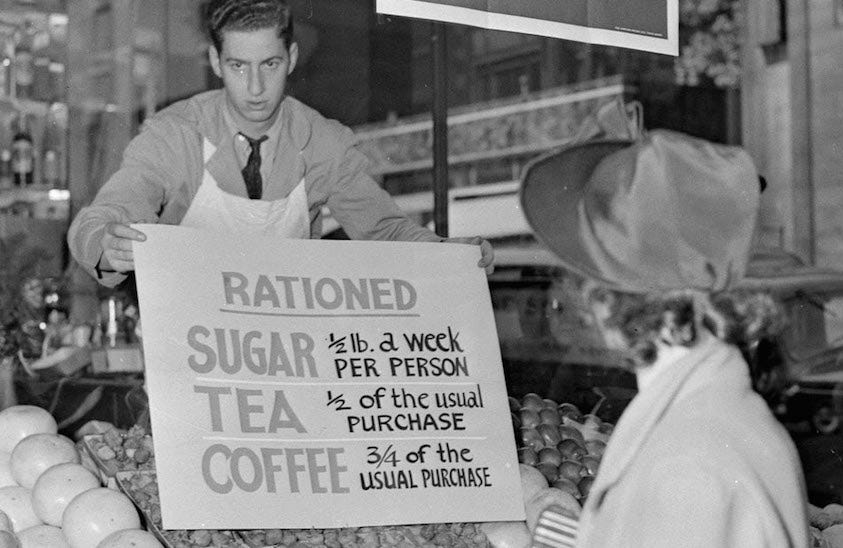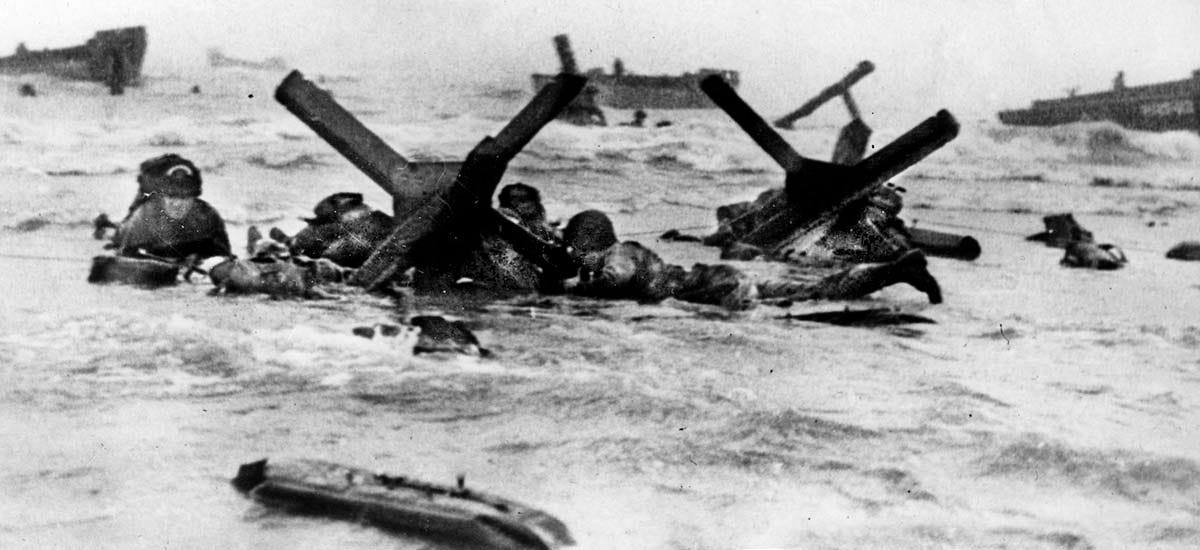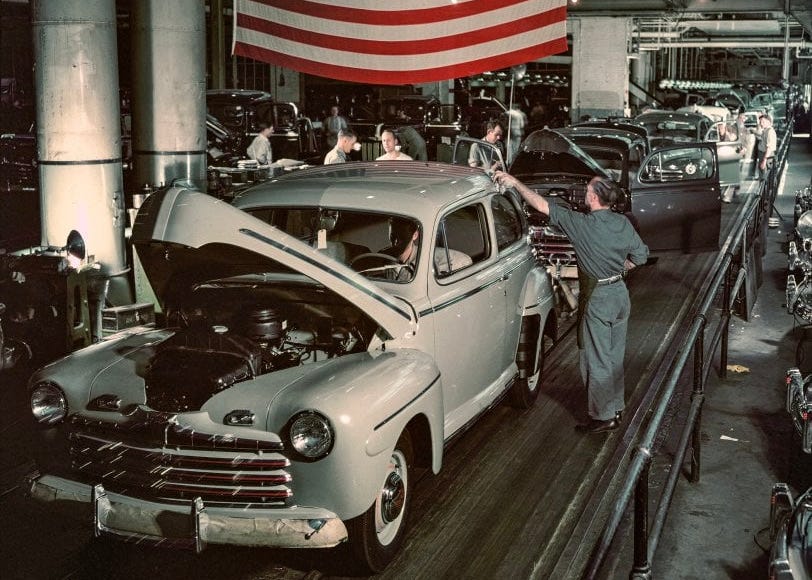A principal goal of Stark Realities is to “expose fundamental myths across the political spectrum” — and few myths are as universally embraced as the notion that US participation in World War II (1941-1945) lifted the American economy out of the Great Depression.
This myth is dangerous not only because it leads citizens and politicians to see a bright side of war that doesn’t really exist, but also because it helps foster a belief that government spending is essential to countering economic downturns. That belief, in turn, has helped propel us to a point where the national debt now exceeds $34.6 trillion, with interest payments alone on pace to reach $1 trillion a year in 2026, inviting financial catastrophe.
In part, the wartime-prosperity myth springs from the fact that, during conflict on the scale of World War II, broad, macroeconomic measures like gross national product (GNP) and the unemployment rate are completely untethered from the economy’s most important facet: the standard of living enjoyed — or endured— by everyday people.
Between 1940 and 1944, real GNP rose at an unprecedented 13% annual clip. Using GNP alone, one would think the war delivered a major improvement in the standard of living, with Americans enjoying a greater abundance of goods, accompanied by a rise in quality, selection and affordability.
The reality was the exact opposite: Americans endured rationing, shortages, declining product quality, and the outright unavailability of many new goods, such as cars, trucks and stoves. This was the inevitable result of factories and raw materials being redirected from the creation of things consumers want to building things like tanks and fighter planes that do nothing whatsoever to improve people’s lives (setting aside the separate issue of the war’s justness).
In many respects, America experienced an outright economic devolution. In the preceding century, industrialization and the division of labor led to enormous increases in productivity. During World War II, however, shortages motivated people who’d contentedly relied on farmers to start growing their own food and canning it. The scarcity of new clothing led homemakers to redirect time and energy to sewing their own garments and resewing them to stretch as much use out them as possible.
“Those remaining on the home front were forced to produce for themselves what they had previously been able to purchase,” wrote Steven Horwitz and Michael J. McPhillips. “The household again became a center of production rather than consumption alone.”
GNP wasn’t the only measure falsely signaling wartime prosperity; employment numbers from the era were likewise misleading. The US unemployment rate plummeted from 17% in 1939 to 1.2% in 1944. Note, however, that military service members are not considered part of the labor force — which means that the draft extracted 11.5 million men from the denominator in the unemployment rate calculation.
Another 6.3 million volunteered, though many signed up because they preferred to secure a role they favored rather than face the chance of being drafted as an infantryman.
While it’s true that draftees and volunteers were “employed” by the armed forces, all these millions of men — no matter how noble their overseas missions may have been — weren’t doing anything to create prosperity at home.
Not a prosperous path to full employment: Soldiers under withering fire on D-Day’s Omaha Beach
That’s not to say the war machine didn’t demand laborers. With so many able men taken out of the economy, the slack was taken up by teenagers, women and retirees, many who’d have preferred to be doing other things.
In a growing economy, more people are producing goods and services, and elevating standards of living in the process. That was far from the case during World War II. Factories were humming, but they were making bayonets, bombs and battleships. “Four-tenths of the total labor force was not being used to produce consumer goods or capital capable of yielding consumer goods in the future,” noted Robert Higgs.
Defying conventional wisdom about “wartime prosperity,” Americans’ standard of living suffered tremendously from their government’s entry into World War II. In The Reality of the Wartime Economy, Horwitz and McPhillips tapped some interesting source material to bring the grim economic realities of American life during World War II into sharp focus.
For example, a series of newspaper ads placed by Canton Electric Light & Power Company — a local New York State utility — present a vivid, time-lapse portrayal of rapidly declining conditions following the December 1941 declaration of war:
- Foreshadowing anticipated shortages, a March 17, 1942 ad for appliances is headlined “You Can Still Buy Them.” The ad includes a qualifier that’s upbeat while still signaling creeping scarcity: “We have a fairly good supply.”
- Just two months later, Canton Electric’s ad says “Now Is The Time” to buy various appliances and equipment, warning that “production of most of these items has stopped and only the supply in your dealers’ stock is available.”
- Another two months later, a July 1942 ad indicates that some items that were briefly not available are back in inventory.
- In November of that first year of America’s World War II participation, Canton Electric switched to warning consumers that, “due to the war emergency, it is quite impossible to get replacement motors for civilian use,” and urging them to ensure they’re properly maintaining their “stokers and oil burners.”
- Later that same month, Canton Electric punted on advancing its retail business altogether, instead using its ad space to encourage readers to grow their own food, eat everything on their plates and comply with ration-stamp rules.
Horwitz and McPhillips also drew on letters written between 1942 and 1945 by Saidee Leach to her son serving in the Pacific. Contrary to the image of prosperity supposedly indicated by leaping GNP or plummeting unemployment, she tells him of:
- Conserving scarce home-heating fuel during the coldest days by wearing fur coats indoors and residing only in their kitchen
- Having her typewriter seized by the government, and now using a lesser model she acquired from a Howard Johnson “which had to close due to the ban on pleasure driving.”
- Making an Easter dinner centered on fried Spam, because she “could not get fresh meat of any kind,” and later noting that “potatoes have entirely disappeared”
- Local farmers refusing to sell their turkey flocks for Thanksgiving meals at the prices set by the Office of Price Administration — illustrating the folly of government price controls.
That is not the picture of an economy delivered from the Great Depression. Rather, “World War II institutionalized the falling standards of living of the depression through wage and price controls, and extensive rationing of consumer goods and services,” wrote Peter Ferrara. “The economic deprivation, and reduced standards of living, continued, although people perceived it was now for a good cause.”
Support Ad-Free, Independent Journalism
America’s postwar experience presents another pointed contradiction of the myth of wartime prosperity.
As the war’s end grew closer, Keynesian economists unanimously predicted peace would bring economic disaster. For example, Paul Samuelson said America would experience “the greatest period of unemployment and dislocation any economy has ever faced.”
Alvin Hansen warned that the economy must be kept on a centrally-controlled wartime footing, even in peacetime: “When the war is over, the government cannot just disband the Army, close down munitions factories, stop building ships, and remove all economic control.”

Nobel Prize winner Paul Samuelson, who predicted peace would bring economic disaster, taught Nobel Prize winner Paul Krugman, who predicted the internet’s impact would be akin to that of the fax machine
However, that’s pretty much what happened — and Hansen, Samuelson and their fellow economic flat-Earthers couldn’t have been more wrong about the consequences. “The year 1946, when civilian output increased by about 30 percent, was the most glorious single year in the entire history of the U.S. economy,” wrote Higgs.
This despite the fact that government purchases of goods and services collapsed by 68% between the second quarter of 1945 and the first quarter of 1946 — and upwards of a million civilian government employees were laid off and millions of service members discharged.
As war-fighting men poured back into civilian life, millions of women withdrew from the labor force, contentedly returning to duty as mothers and home managers. Rather than soaring as predicted by the “experts,” unemployment merely edged higher, from 1.9% in 1945 to 3.9% in 1947.
“Less than a year and a half after VJ-day,” crowed President Truman, “more than 10 million demobilized veterans and other millions of wartime workers have found employment in the swiftest and most gigantic change-over that any nation has ever made from war to peace.” (Note this happened despite — and in part because of — Truman’s failure to institute a higher minimum wage as the war ended.)
Having been proven enormously wrong about the economic implications of peace, Keynesians scrambled to credit the war with enabling the postwar boom, arguing that it was fueled by people drawing down savings accumulated while the supply of consumer goods was sharply restricted. However, as Higgs determined by studying the data of the time, “Holdings of liquid assets did not decline at all after the war. People financed their spending for consumer goods by reducing their saving rate.”
Once again an engine of real prosperity: In 1946, vehicles proceed along Ford’s first postwar assembly line
Contrary to the myth, it was only after World War II that — free from the government’s commandeering of factories, workers and resources, and saddled with fewer price controls and other federal market intrusions — America was finally able to emerge from the Great Depression.
You wouldn’t know that if you evaluated the economy’s health using Keynesians’ preferred measure. Just as the GNP gauge provided a 180-degree misreading of wartime economic realities, it failed in similarly spectacular fashion during the postwar boom: From 1945 to 1947, GNP plummeted 22%.
In addition to further illuminating the shortfalls of aggregate economic measures, America’s postwar economic experience delivered another broadside to the myth of World War II-fostered prosperity, and to the idea that government spending, central planning and market interventions are essential to economic achieving economic recovery.
April 7, 2024
Posted by aletho |
Economics, Militarism, Timeless or most popular | United States |
Leave a comment

Palestinians inspect destroyed residences in Khan Younis after Israeli military withdraws most of its ground troops from the southern Gaza Strip (Reuters)
Israel says it has pulled most of its troops out of southern Gaza in what it said is a move to recuperate and prepare for future offensives.
Three Israeli brigades on Sunday left the southern city of Khan Yunis but another remained to prevent displaced Palestinians from returning to their homes in the north.
The Israeli military said a “significant force” will remain in the rest of the besieged Gaza Strip.
Israel’s military earlier announced it’s pulling thousands of soldiers out of the south, including Khan Younis city, after months of fierce combat.
The military wing of the Hamas resistance movement said Israel was forced to end its operations before achieving its goals.
The al-Qassam Brigades dismissed Israel’s claims that it had destroyed resistance forces in those areas from where it had withdrawn.
The Brigades added that resistance forces have always surprised Israel.
Khan Younis residents, who rushed back to their city after Israeli forces relocated from southern Gaza, found a wasteland of destruction and rubble.
Media reports quoting residents said much of Khan Younis had been destroyed, many buildings had been bombed, and there were overturned cars stuck in the mud near craters left by missiles.
Witnesses said that damaged hospital beds were seen on one street.
They have been saying the situation is completely indescribable and chaotic as a great deal of destruction has been done to the entire area
“It is a shock, a shock. What happened was not small … while coming on the way in the car, I saw things. The destruction is unbearable,” said Mohammed Abou Diab, who was among those who returned to his old neighborhood.
The Secretary-General and CEO of the International Federation of Red Cross and Red Crescent Societies (IFRC), Jagan Chapagain, says the situation in Gaza is “desperate and worsening” as the war hits its six-month anniversary.
The city has come under intense Israeli bombardment in recent months.
Khan Younis has been destroyed, with the destruction of civil infrastructure, mosques, and residential houses, and people are saying that they have nothing left in the city.
After six months of relentless attacks on Gaza, Israel remains no closer to a victory than it has been at any point since October of last year.
US says Israeli military’s troop reduction in Gaza is to ‘rest and refit’
White House National Security spokesperson John Kirby said the Israeli army’s troop reduction in Gaza appears to be a “rest and refit” and not necessarily indicative of any new operations.
“As we understand it, and through their public announcements, it is really just about rest and refit for these troops.”
“[This is] not necessarily that we can tell indicative of some coming new operation for these troops,” Kirby said when asked about the step.
Palestinians face more deaths and destruction in Gaza as the US-Israeli onslaught in the besieged strip continues for a seventh month.
Since the beginning of the US-Israeli genocide in Gaza, nearly 33,200 people have been killed.
At least 7,000 people are also unaccounted for or presumed dead under the rubble.
April 7, 2024
Posted by aletho |
Ethnic Cleansing, Racism, Zionism | Israel, Palestine, United States, Zionism |
1 Comment

Peter Pellegrini (L) and Slovak Prime Minister Robert Fico (R) after the announcement of Pellegrini’s victory in the Slovak presidential elections, April 6, 2024.
Slovak parliamentary speaker Peter Pellegrini, who shares prime minister Robert Fico’s staunch opposition to continued arms supplies to Ukraine, won the second round of Slovakia’s presidential election. Pellegrini and Fico’s left-wing opposition to the Russo-Ukraine war proved to be a winning formula.
In Peter Pellegrini Slovakia will finally have a president who does not support the pro-Western position and was not “installed by the Americans,” political observer Peter Marcek told Sputnik.
“There will be coordination between the government of the Slovak Republic [led by] Robert Fico and President Peter Pellegrini, because they have one program, one direction,” he remarked.
According to Marcek, “both Fico and Pellegrini share the idea that no Anglo-Saxons should be able to dictate to us what we should do.”
Washington pursued its own goals by pushing Pellegrini’s main rival, former foreign minister Ivan Korcok, for the presidency, argued the expert, in an effort “to subordinate our will exclusively to their hegemony.”
Pellegrini, an ally of Fico, won the presidential election with 53.26 percent of the vote versus Korcok’s 46.73 percent, following declarations from 99.66 percent of voting districts.
Pellegrini said his victory meant the government would not have to face an “opposition, opportunistic power centre.” He vowed that he would “be a president who will support the government in its efforts for improving people’s lives.”
Pellegrini, 48, has Italian ancestry. He previously served as Slovakia’s prime minister from 2018 to 2020 and Minister of Health from 2019 to 2020. He also had a two-year stint as speaker of the National Council from 2014 to 2016. Pellegrini, formerly a member of Direction – Social Democracy, left that party to found Voice – Social Democracy in 2020.
The politician returned to the position of Speaker of the National Council after the 2023 parliamentary election. His Voice – Social Democracy party came third and became part of the three-party ruling coalition with PM Robert Fico’s SMER-SSD (Direction-Slovak Social Democracy) and the Slovak National Party.
Pellegrini announced his intention to run for president in January. He came second in the first round of voting in March, with 37.03 percent, trailing former Korcok who won 42.52 percent of the vote. But Pellegrini scooped up the floating voters to clinch the second round.
Commenting on the Fico and Pellegrini long-standing political alliance, Marcek pointed out that “When the government passes laws and the president can veto them, it creates problems.” But now the president and the prime minister will be on the same page.
“Pelligrini will be a president who will work well with Fico. They said at a press conference after the elections that they would support each other. They will cooperate very well this way,” said the pundit.
In Slovakia, the government holds most of the executive powers, such as picking the prime minister after parliamentary elections, swearing in the new government, and appointing Constitutional Court judges. The role of president is largely ceremonial, but includes ratifying international treaties, appointing top judges and acting as commander-in-chief of the armed forces — and has the power to veto new laws.
Bratislava can no longer support the West’s anti-Russian course, noted Marcek, who welcomed the “clear victory of Pellegrini.”
“I think that many relations, for example, with the Russian Federation, can improve. We need to develop our mutual relations,” stated the former deputy of the Slovak parliament.
“I am grateful to Russia because it is not just fighting for itself, to prevent NATO from approaching the borders of the Russian Federation,” Marcek stressed. “Russia is fighting for us all, for the traditional family values, for improving the economic situation in the world. For good relations, and most importantly — for peace and justice.”
Fico’s government has been determined to chart an independent course against NATO’s proxy war against Russia in Ukraine.
Echoing his Hungarian counterpart Victor Orban’s stance, Fico has opposed confrontation with Russia, and urged an end to military aid to Kiev. Hungary and Slovakia are the only two EU and NATO members to refuse to send arms to Ukraine.
“Peter Pellegrini hails from Robert Fico’s party, he is a social democrat, and shares the PM’s ideas and views. This means that he is in favor of ending the conflict in Ukraine and starting negotiations between Kiev and Moscow,” Marcek said. “He is against sending weapons to Ukraine, opposes such vast quantities of EU aid being sent to Kiev.”
Pellegrini stated in an interview in March that the Slovak government had a realistic position on the conflict, and voiced surprise that some countries refuse to respect Slovakia’s approach. He added that Slovakia is ready to help the Ukrainian side in demining territories and implementing civilian projects.
The president-elect believes that the conflict in Ukraine has no military solution, advocates early peace negotiations and believes that arming Ukraine could ultimately lead to disaster.
Most Slovaks want “a president who will defend Slovakia’s national interests, who will not drag Slovakia into a war but will talk about peace, who… will put Slovakia’s interests first,” Pellegrini said.
In contrast, Pellegrini’s opponent Korcok, said: “I do not think Ukraine should give up part of its territory to achieve peace.” He told reporters that “Peace cannot mean capitulation,” and could only be achieved “immediately” on the condition that Russian troops withdraw.
Fico responded by calling Korcok a “warmonger” on video ahead of the run-off. He claimed Korcok “will support everything the West tells him without hesitation, including dragging Slovakia into the war.”
But both Pellegrini and Korcok have reiterated that they would not allow the Slovak military to be sent to Ukraine.
“Slovakia has made a decision that it will not send a single soldier to Ukraine in any event. And this is despite the criticism of this sovereign position of ours. On the contrary, we will insist that the only way to end the bloodshed is to have courage to begin peace talks between the warring parties,” Pellegrini said after a meeting with Orban.
On issues such as NATO membership for Ukraine, however, the two rivals took opposing stances. Korcok insisted that the final decision on Ukraine’s membership in NATO will be made by members of the alliance if the Ukrainian side meets the necessary requirements.
But Pellegrini was adamant that there is no place for Ukraine in NATO, giving an unequivocal “no” to the question during a pre-election debate on the Markiza TV channel.
“NATO, in my opinion, is the most aggressive group of armies, that only exist to foster wars all over the world, spearheaded by the United States. And Peter Pelligrini will absolutely not agree with this,” Marcek said.
Asked how Pellegrini’s victory could affect European Union policies and if Slovakia might use its veto on issues such as aid to the Kiev regime, the political analyst said that Slovakia now had “new opportunities.”
“We will not give up the veto power to anyone,” Marcek insisted. “This is our right, even though we are a small country. Together with Viktor Orban, 100 percent we will not cede this to anyone.”
Marcek slammed European governments that were “pro-American, pro-Brussels,” adding that “They are for war against Russia.”
“Macron still wants to send soldiers to Ukraine. The government in the Czech Republic wants to continue the war, but the citizens do not,” he said. “We say, ‘We shall have none of this’.”
April 7, 2024
Posted by aletho |
Militarism | European Union, NATO, Slovakia |
1 Comment
February 10, 2021 I gave a short talk on PCR (Polymerase Chain Reaction) titled Wag The Dog.
In 1983, Kary Mullis invented PCR, which stands for polymerase chain reaction. In 1993 he got the Nobel Prize for PCR. PCR is like a photocopier that can make billions of copies of a single fragment of DNA. Kary and I met through our mutual friend Peter Duesberg, a professor at the University of California at Berkeley. In 1997, Peter, Kary, and I were invited to a meeting on AIDS in Colombia, South America. Kary explained why his truly amazing invention PCR cannot detect viruses in people or diagnose infections.
April 7, 2024
Posted by aletho |
Deception, Science and Pseudo-Science, Timeless or most popular, Video |
Leave a comment
The 184th day of the Israeli genocidal war on Gaza witnessed a dramatic development represented by the Zionist military withdrawal from southern Gaza.
In this context, the Israeli military radio said that the army withdrew Division 98 with its 3 brigades from Khan Younis, adding that only Nahal Brigade remained in the Strip, specifically at Natsarim crossing, which separates the Gaza’s north and south.
Reuters news agency quoted the Zionist military spokesperson as saying that the Israeli army has withdrawn all ground troops from South Gaza, except one brigade.
The Israeli occupation army announced the death of 4 soldiers during battles in southern Gaza.
Meanwhile, the Zionist occupation forces continued bombarding the innocent civilians in the various areas of Gaza, claiming more martyrs.
The Israeli warplanes and artillery struck civilian targets in Khan Younis, Rafah, and Gaza city.
The Palestinian health ministry reported that the Israeli occupation forces committed four massacres during the past 24 hours in Gaza, killing 38 civilians and injuring 71 others.
Thus, the latest toll of the Zionist genocidal war in Gaza has become 33,175 martyrs and 75,886 injuries.
April 7, 2024
Posted by aletho |
Ethnic Cleansing, Racism, Zionism | Gaza, Israel, Palestine, Zionism |
Leave a comment
London pharmacist Nazim Ali has finally won his long running legal battle against Zionist regime proxies, a battle which started in 2017 when Nazim Ali spoke at the Quds Day Rally following which the Campaign Against Anti-Semitism, (CAA), lodged a complaint with the Police accusing Nazim Ali of Anti-Semitism.
The Crown Prosecution Service, however, refused to press charges.
The Zionists took a private prosecution that was eventually stopped by the CPS. They took out a judicial review against the CPS and lost.
In January 2019 Ali’s professional regulator, the General Pharmaceutical Council (GPhC), which is responsible for the independent regulation of the pharmacy profession within England, Scotland and Wales, as well as the regulation of pharmacists, pharmacy technicians and pharmacy premises, said there was no case to answer, but gave him a warning for being offensive.
The Campaign Against Anti-Semitism (CAA) then bullied the regulator into reversing its position in July of that year.
The council concluded his words were not anti-semitic in November 2020. But the UK lawyers for Israel joined the campaign against Anti-Semitism to continue to harass Ali.
In December 2020, a complaint was lodged with the body which regulates the regulator, the Professional Standards Authority for Health and Social Care or PSA.
The intimidation worked and the PSA took the GPhC to court, at which point the GPhC folded and offered no defense.
The high court then sent the case back to the GPhC which made the absurd determination that two of Ali’s remarks were objectively, if unintentionally, anti-semitic. However, it gave him a warning, as it had before.
The Zionists were still not happy and appealed to the courts to get Ali sacked. In March this year, the Court declared that there was no case to answer.
This is a historic and hard fought victory.
But who are Zionist groups who have bullied and intimidated the professional regulators into such submission?
The Campaign Against anti-Semitism took up the cudgels first; the CAA is a creature of the Zionist regime which was set up to attack the pro-Palestine movement with fake anti-Semitism allegations.
Much of its early funding came from the Jewish National Fund, the racist land-theft group, which is one of the four so called national institutions in Israel.
The UK Lawyers for Israel is a group which appears to have been set up under the auspices of the Israeli Ministry of Foreign Affairs. Its whole purpose is to use ‘lawfare’ tactics to manipulate the law and bully British institutions into doing its bidding.
The case of Nazim Ali reveals how foreign agents of the Zionist regime can harass, bully, and intimidate the UK so effectively that they can, in effect, occupy the professional bodies regulating the profession of pharmacy, which is a clear cut case of state capture.
It also tells us that people can fight back and win.
In fact, this is one of a number of recent victories against the Zionist movement.
It would appear, for all intents and purposes, that the tide is turning.
April 7, 2024
Posted by aletho |
Civil Liberties, Ethnic Cleansing, Racism, Zionism | Human rights, UK, Zionism |
Leave a comment
The great statins divide: As go-ahead’s given for one in four adults to be offered heart drug, one doctor says this mass pill-popping is folly…
- NICE has recommended statins be made available to patients with a 10% risk or more of having a heart attack within a decade
- This would see up to 12 million patients taking the drug every day
- Dr Aseem Malhotra believes up to one in five patients suffer side-effects
- He suggests tackling obesity would have a bigger impact on lowering death rates
The man in my consulting room was in his mid-50s and had arrived complaining of severe chest pain. ‘I’ve had it for a while now, doctor,’ he said, grimacing, ‘it won’t go away.’
I glanced at his notes — an angiogram had showed that his heart was fine, while an endoscopy had revealed there was nothing untoward going on in his oesophagus or stomach. Then I asked what drugs he was taking regularly. ‘Well, nothing really?.?.?. just statins.’
That was almost certainly the culprit. I asked him to stop taking them for a fortnight, which, despite protests from his GP, he did and, lo and behold, two weeks later the patient was pain-free.
I recommended he embrace the so-called Mediterranean diet and exercise a little more, and he went away a happy and healthy middle-aged man.
If NICE (the National Institute for Clinical Excellence) gets its way, that scenario could be needlessly played out in GP surgeries and hospital consulting rooms hundreds of thousands of times a year. It would mean 12 million of us taking a little pill before bed, five million more than take statins today.
That’s five million more patients for the NHS to keep an eye on, five million more people who, despite the fact many will be in good health, have been well and truly ‘medicalised’ and face the prospect of spending the rest of their lives on daily medication.
In making its recommendation, NICE seems to be siding firmly with the drug companies and relying on industry- sponsored statistics which consistently under-report — some would even say hide — the risk of side-effects.
These statistics will tell you that perhaps one in 10,000 patients taking statins will suffer severe muscular pain as a side-effect.
In contrast, reliable data from the real world, published recently in the British Medical Journal and backed up by anecdotal evidence from my experience as a cardiac physician, suggests that the real figure for serious side-effects associated with statin use is closer to one in five.
In other words, if NICE succeeds in turning five million middle-aged and predominantly healthy men and women into statin-popping patients, then one million of them will be back — just like my fiftysomething patient — in surgeries and consulting rooms, complaining of side-effects that, as well as muscle pain, include digestive problems, short-term memory loss, erectile dysfunction, sleep disorders, cataracts (mainly in women) and even type 2 diabetes.
The drug companies will tell you how cheap statins are — just 10p a day — but that completely ignores the costs of the follow-up appointments and hospital investigations that patients suffering from such side-effects will require.
With even NICE admitting that 140 people will have to take statins to prevent just one of them having a heart attack or stroke, that’s 139 people taking them for no good reason, running the risk of unpleasant side-effects in the process while all the time taxpayers pick up the ever-growing bill for looking after them.
But NICE also seems to be ignoring serious doubts about how effective statins are.
Yes, they can lower cholesterol levels (they work by inhibiting an enzyme that produces cholesterol in the liver), but real-world data show they have absolutely no effect on either overall death rates or rates of serious illness.
The advocates of statins will point to falling death rates from heart attacks and strokes in recent years but many clinicians — myself included — believe that death rates are falling not because of the increased use of statins, but because of the decrease in smoking (a smoker is 50 per cent more likely to die from a heart attack than a non-smoker who’s had a heart attack) and more effective intervention in Accident and Emergency.
Good medicine involves the right treatment being given to the right patient at the right time, and I’m the first to admit that statins have an important role to play when it comes to the care of patients who have either had heart attacks or have been diagnosed with heart disease.
But giving them to millions of reasonably healthy people is not only medically dubious, it also risks sending out entirely the wrong message to those who, as they approach middle-age, ought to be giving very serious thought to their own diet and lifestyle.
The next big decrease in deaths from heart attacks won’t be brought about by doling out statins but by doing battle with the biggest — and still growing — health problem that we, in common with other Western nations, face: obesity.
Being overweight and having a poor diet causes more serious health problems than alcohol and smoking put together, with obesity associated with such serious conditions as type 2 diabetes, high blood pressure, cancer and cardiovascular disease.
My biggest worry about statins is that people will see them as a magic pill that allows them to tuck into three pizzas a night and umpteen hamburgers with impunity. But they aren’t. People who want to take care of their health, need to make changes themselves.
It’s not that difficult. The Mediterranean diet simply involves more olive oil, more nuts, two to three portions of oily fish a week and lots of fruit and vegetables, while cutting out refined sugars and carbohydrates (so no white bread, rice or pasta) and processed foods laden with fats and salt.
As for exercise, I’m not talking about training for a marathon — a brisk 20-minute daily walk will do great things for your cardiac health.
Make those sort of lifestyle changes and — whatever NICE says — you won’t need those statins at all.
April 7, 2024
Posted by aletho |
Science and Pseudo-Science, Timeless or most popular |
Leave a comment







